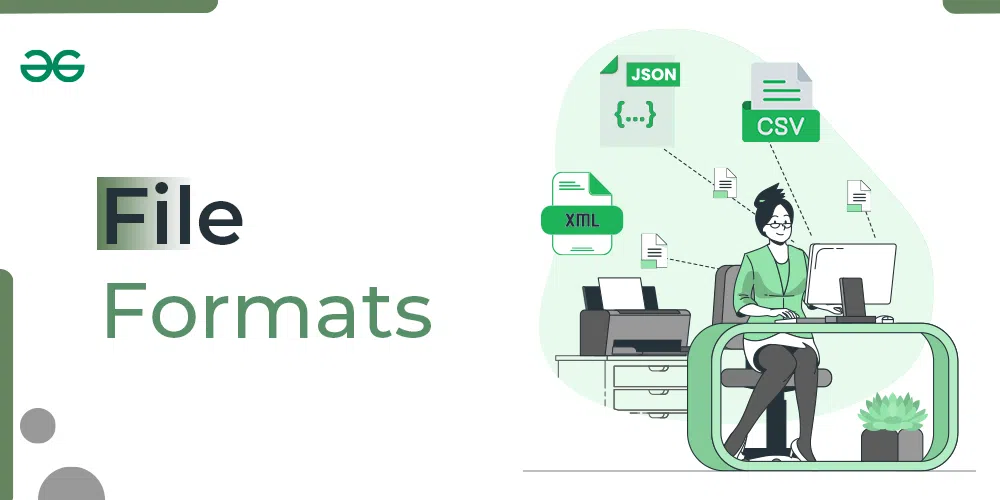
File Formats store a large variety of raw information in a structured format so that the data can be easily stored, processed, and harnessed. A file format is a standard way of storing data on a computer file. There are multiple types of file formats present which can be used to store and retrieve data efficiently. We will discuss the unique features and use cases for different kinds of file formats and compare them.

As the technology is growing it has become more important to save the data in an organised and structured manner.
Table of Content
Explore a wide range of common file formats and learn how to work with them effectively.
Recent File format published articles.
Microsoft Outlook message format; contains email messages with formatting, attachments, and other information.
| Extension | Full Form | Description |
|---|---|---|
| .jpg | Joint Photographic Experts Group | A lossy compression format that is commonly used for photographs and other images with a lot of detail. |
| .png | Portable Network Graphics | A lossless compression format that is commonly used for images with sharp edges or text. |
| .webp | Web Picture Format | It Supports both lossy and lossless image compression with support of 24-bit RGB color. |
| .gif | Graphics Interchange Format | The limited-color format is commonly used for animations and small images. |
| .tif | Tagged Image File Format | High-quality format that is commonly used for professional photography and printing. |
| .bmp | Bitmap | An uncompressed format that is commonly used by Microsoft Windows. |
| .eps | Encapsulated PostScript file | A vector format that is commonly used for print graphics. |
Windows Media Audio
Used for storing audio data, commonly associated with Sun Microsystems.
Advanced Audio Coding
Used as an in-vogue sound field design for packed virtual sound and tune data.
| Extension | Full Form | Description |
|---|---|---|
| .mp4 | MPEG-4 Video File | Multimedia container format that commonly stores video and audio data. |
| .3gp | 3GPP Multimedia File | Multimedia container format that is commonly used for mobile phones. |
| .avi | Audio Video Interleave File | An older multimedia container format that is still supported by many devices. |
| .mpg | MPEG Video File | Older video compression format that is still supported by some devices. |
| .mov | Apple QuickTime Movie | The format that is commonly used by Apple devices. |
| .wmv | Windows Media Video File | The format that is commonly used by Microsoft devices. |
Batch file format used to automate tasks on Windows systems; contains a series of commands to be executed by the command interpreter.
A COM file is an executable file format used for programs on older Windows systems. COM files have limited functionality compared to modern formats.
An executable file is a type of computer file that contains compiled code that can be run directly by the operating system. Executable files are commonly used to run programs.
ARC archive file
An ARC file is an archive file format used for compressing and storing files. ARC is an outdated format and has been replaced by ZIP and other newer options.
StuffIt archive file
A SIT file is an archive file format used on Macintosh systems. SIT is similar to ARC but is specific to Macs.
GZIP compressed file
A GZ file is a file format created with gzip compression. Gzip shrinks the size of files for storage and transmission.
A Z file is a compressed file format associated with the “compress” compression program on Unix systems.
HyperText Markup Language File
Hypertext Markup Language (HTML) document format with the less common file extension; identical to .html files.
Ans. File formats are necessary as they help to determine in what structure the data will be stored, accessed, processed, archived and processed. It sets a standard to store information in a computer file.
Ans. File extension are characters written after period symbol in a file name. They are used by the operating systems to define which program is the file associated with. File extensions indicate the file format and cannot be renamed.
Ans. JSON is used for data exchange in modern day web development as it is lightweight and compact. CSV is used when the amount of data to send is large and there are bandwidth issues. XML was used in document markups and its popularity has decreased after the introduction of JSON.
Ans. To choose a data format, we should have a clear understanding of what type of data we are going to work with. If the data is to be kept lightweight and compact we should prefer JSON format for storing data. If we want a structure data in format of row and column an the amount of data is large we should use XML anf if we are working on legacy projects we will generally work with XML data format for document markups.